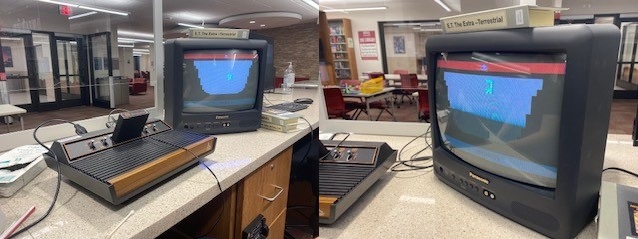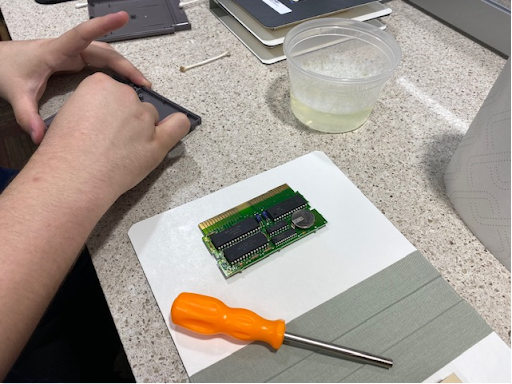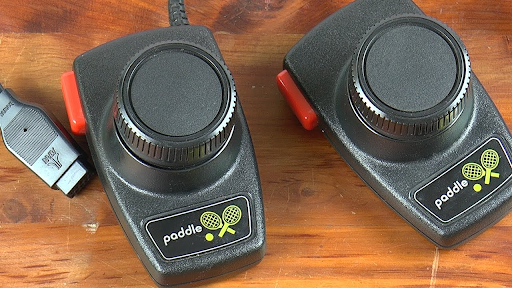
Legacy Games: Cultural Context and Importance
Down in the Media Services department here at the Wells Library, a special collection consisting of hundreds of video games and over a dozen consoles is available for public use. The games held in this collection range in age from a 1972 version of the game Pong, to the PlayStation 5 version of Elden Ring (2022). In creating a library guide for these items (“libguide,” for short), I found myself handling the very same games my father played in arcades and at cousins’ houses as a child in the 1970s and 80s. As I snapped the occasional picture to send off to him, ’Do you remember this one?’, he would respond with stories about spending the summer playing Pong and watching the first Star Wars. It resonated with me, the cultural importance and personal meaning these games have despite their pervasive societal status as sort-of mindless entertainment. Pong‘s two-dimensional dots bouncing around a screen are absurdly primitive from today’s perspective of photo-realistic video game worlds and ever-enhancing gameplay: ‘You were entertained by this?!’
I do not think it is a radical statement to say that there is something of a lowbrow stigma attached to video games. Unlike film, which early-on attracted the attention of people like Henri Langlois and Iris Barry, who championed the medium’s artistic and cultural value, video games have historically been associated with the cultural spheres of children’s games and comic-book-guy tropes. Despite this, video games have been preserved by collectors, enthusiasts, and, in recent years, universities. The University of Illinois and the University of Michigan both hold extensive collections of vintage consoles and games. As we evaluated our collection of games and consoles at IU Libraries’ Media Services, I looked to the established best practices of video game archival pioneers and leaned on my classroom knowledge from courses like Audio Preservation, Digital Curation, and Moving Image Preservation.
Preservation: Considerations and Challenges

Credit (both photos): Sarah Bull
To begin this project, I considered some of the difficulties facing people charged with preserving games. In the archival world, the preservation of the original item is a key best practice. In the case of physical, digital-based media like game cartridges and CD-ROMS, issues like software and hardware obsolescence, as well as regular old degradation can make this task very difficult to accomplish. Digital copies can be created and emulated on modern equipment but lack the same character and feel as original copies on original equipment. Additionally, and perhaps more importantly, academic libraries looking to make digital copies of video games must contend with restrictive copyright law, which adds a layer of confusion to the process for researchers and preservationists alike.

Photo Credit: Sarah Bull
Media Services holds over 100 Atari games, and about 100 NES (Nintendo Entertainment System) games, and together these make up the oldest portion of our game collection. In working on this project, we’ve tested nearly all of these items, and found that if they did not work immediately, they worked after a little cleaning with some isopropyl alcohol. We also found that seven of our NES games contained batteries, which were used for saving game data. To check the health of those batteries, we opened the cartridges, cleaning the plastic interiors gently with a mild soap and water solution, and found that all batteries were clean and in good working order. This did raise a tricky question: Do we ‘decommission’ the games by taking the battery out, thus reducing the risk of decay and corrosion, or do we leave the batteries in so as to allow the games to be used? For the moment, we decided to leave the batteries intact. One other issue we found while combing through the collection was that several of our Atari games work, but are unplayable due to their need for a special ‘paddle’ controller the department does not currently own. Orders have been placed to make that controller available in Media Services, but this provides a good example of equipment scarcity as a preservation risk.

Photo Credit: Atari Paddle Controller Design
While IU does have a large, temperature- and humidity-controlled facility for both archival and overflow items, using offsite storage tends to limit the usability of an item. To the greatest extent possible, Media Services wants to continue ensuring our video game collection is usable. Fortunately, we have found that our space in the ground level of the Wells Library is optimal for keeping video games in good condition, with no sunlight, major temperature shifts, or high humidity to hasten degradation.
Despite Media Services being an ideal storage space for video games, the items held here will not last forever. While in this article I have largely focused on game cartridges, it should be noted that games stored on CD-ROMs are also at risk: anything from obsolete software to easily-created disc scratches can permanently affect or damage a game’s playability. This is to say nothing of modern games, with many new games published exclusively for online play, with no physical title for a library or archive to hold. For these, future preservationists will need to navigate both proprietary software and copyright restrictions. As we move forward, it is important to be aware of the continually evolving risks and challenges to long-term game preservation and to mitigate those wherever possible. SB
For the past few years, this week’s blogger Sarah Bull has been a student staff member in a number of departments at Wells Library, including Media Services. Sarah received her Master’s Degree in Library Science in Spring, 2022. This is her final blog post for Media Beat. Sarah has made many meaningful contributions to Media Services during her tenure here, and we wish her the best in her future endeavors!
Works Consulted
Yee, Jared. “Incompatible: The Challenges in Preserving Taiwanese Video Games.” 2021 Pacific Neighborhood Consortium Annual Conference and Joint Meetings (PNC), Consortium Annual Conference and Joint Meetings (PNC), 2021 Pacific Neighborhood, Sept. 2021, pp. 1–8. EBSCOhost, https://doi.org/10.23919/PNC53575.2021.9672310.
Retro Computing Stack Exchange Forum: How long will SFC/SNES consoles and cartridges last? – Retrocomputing Stack Exchange
Oct. 20th, Rylan Vanacore |. published and 2021. “Preserving Video Game History.” Reporter, https://reporter.rit.edu/tech/preserving-video-game-history. Accessed 11 July 2022.
“Why Some Video Games Are In Danger of Disappearing Forever.” Kotaku, 12 Dec. 2017, https://kotaku.com/why-some-video-games-are-in-danger-of-disappearing-fore-1789609791.
Leave a Reply